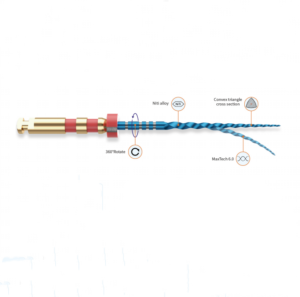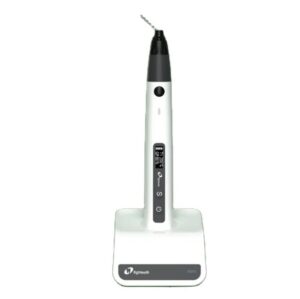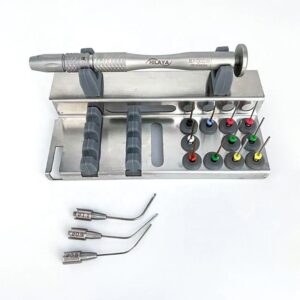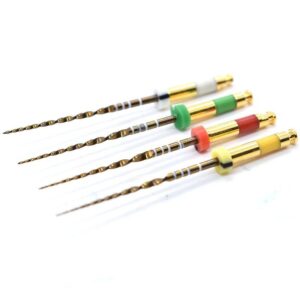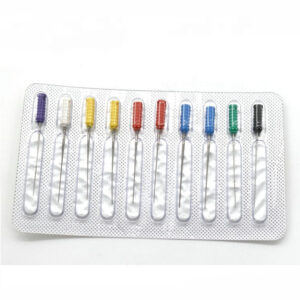Endodontic is a major field of dentistry in which practitioners keep on updating their knowledge to cope with the fast-evolving dental practice. Unique materials, advanced methods, and modern instruments are being introduced that have revolutionized the clinical practice of endodontics. The underlying approaches of root canal treatment include debridement, shaping, and sound filling of the root canal. A variety of endodontic instruments are available to achieve these goals. Endo files and endo reamers are instruments that are used for root canal preparation. Below is a review of different groups of instruments used in endodontics.
Endodontic Hand Files
There are different types of root canal files. Most of the time they are made from stainless steel which gives them a high degree of elasticity and tensile strength. Endo files are mainly used with filing or rasping actions during which there is almost no rotation of instruments in the root canal. The purpose of their usage is complete cleaning and debridement of the root canal up to the length of the apical foramen. Correct usage of endo files facilitates disinfection of the root canal and produces a shape that is suitable for obturation. Following are common types of files used during endodontic treatment:
- K- file
K file, introduced by Kerr Company, is most commonly used for cleaning and shaping. It is made by twisting a rectangular or a square blank into a closely packed series of spirals. This twisting results in 0.9 to 1.9 cutting edge per millimeter length.
1, ISO Classification
These files are classified in group 1 by International Organization for Standardization (ISO). There are different colors on the plastic handles along with the sizes that can easily be distinguished while using. The recommended procedure is to start with the smallest size and increase gradually until the desired shape is obtained.
2, Motion of file
They work either in reaming or push or pull filing motion. They can only be rotated clockwise and if the specific flute design is contorted then the file should no more be used. It is inserted till working length and ¼ to ½ turn after which it is removed while keeping it supported to the wall.
3, Sterilizable
These files can be reused after sterilization by dry heat, glutaraldehyde, and steam autoclave. It is observed that sterilization using this method does not cause corrosion, weakness, or increased rotational failure.
4. Types
Their different types are available in markets. These are mentioned below.
K-flex file
- It has rhomboidal shaped cross section.
- It has alternate acute cutting flutes and obtuse non cutting flutes.
- It has greater flexibility.
- Its disadvantage is that it quickly loses its cutting efficiency.
K-flexofile
- It is more flexible and resistant to fracture.
- It has sharper cutting flutes and more room for debris removal.
K-colorinox file
- It has active cutting tip.
- Available in different size.
- Has quadrangular stem.
Flex R file
It is relatively sharper.
It does not produce steps in preparation.
It is more twisted.
H(headstrom) file
It is formed by milling of steel sheet which is round in cross-section. This results in raised cutting margins. The tapering produces a series of overlapping cones. This pattern produces a sharp and flexible instrument but the file is weak because of the decrease in the diameter of the shaft. Hence, resulting in fracture. Therefore, they should not be rotated more than 30 degrees. It is an effective instrument for capturing and eliminating broken instruments, gutta-percha, and silver points. As they are majorly used for gripping, so their major function is increasing the diameter of the canal after the use of k-file. NiTi or steel are used for their composition.
- ISO Classification
Similar to k-files, they are manufactured according to ISO classifications, with color coding and number on the handle. Thus it is easy to use for the practitioners.
2. Motion
As its main purpose is traction, it is highly efficient when used in pull motion. Moreover, as already mentioned, being prone to fracture they should not be rotated more than 30 degrees.
3. Sterilization
They are also reusable and can be sterilized by using various methods, including dry heat, autoclave, and glutaraldehyde solution without damage affecting their efficiency.
4. Difference from k-files
H-files are more efficient and quicker than k-files. Steps produced by k-file are more visible than that of h-file. Moreover, h-files have secure tips while k-files have sharp tips.
Protaper
Protaper files have triangular cross-sections. They have a convex design with alters the percentage of taper across the length which decreases friction between file and dentine during rotation. Its increasingly tapered pattern enormously increases pliability and cutting efficacy. Protaper files have to save ended flat tips which increase their ability to move through dental debris. The altering helical angle reduces the danger of files accidentally moving into the canal.
The Protaper System
It has 3 shapings and 5 finishing files,
a The shaping file
It is comprised of two shaping files: S1 and S2. S1 has purple rings while S2 has white rings on their handles meant for recognition. The diameter of S1 is 0.17mm while that is 0.02 mm. There is another shaping file called SX (auxiliary shaping file), it has a handle of gold color that has no rings. It is comparatively shorter having a length of 19mm. It is best used in narrow canals. Tapering of the shaping file increase along their length due to which they grip, cut, clean canal, and carry out crown down configuration. SX is used after S1 and S2 files to completely shape canals in fractured crowns or shorter teeth.
b, The finishing files
There are 5 finishing files with identification rings of different colors on their handles. Each color is for a specific file. For instance, the F1 file is identified by yellow color: F2, red; F3, blue; F4, double black and F5, double yellow. Each file has a decrease in taper which increases flexibility and decreases the danger of taper lock. It also lessens the risk of enlarging the coronal tooth head of the canal.
Reamers
They are made by folding a pointed stainless steel blank to form a spiral instrument having acute cutting-edged. They are either made up of triangular or square blank. Following is one of its major types:
K- reamer
- Design
K-reamer has an open twisted pattern. It has 3 cutting corners with a 60-degree tip and an angle of 120 degrees. They are also produced from nickel-titanium and are known as NiTi k-reamers.
2. Usage
They are used to clean the canal walls. It is a great instrument for widening the root canals and removal of debris.
3. Motion
It is used by a pull action after twisting it halfway.
4.ISO Classification
It is available under ISO classification with sizes ranging from 06 to 140.
5. Length
They are found in multiple sizes, including 21mm, 25mm, 28mm, 31mm, and 35mm.
6. Re-usable
They can be sterilized; thus can be used.
Rotary files
With the advent of nickel-titanium in clinical dental practices, the use of rotary instruments for endodontic treatments has increased. Rotary files have increased cutting efficacy as compared to hand instruments. Rotary instruments are used with the help of an electric endodontic motor in which rotation and speed are conveniently controllable. Following are some of the characteristics of rotary files:
- Reciprocating System
It includes anticlockwise as well as clockwise rotation of files. Due to this character, it efficiently grips dentine and results in the shaving of dentinal chips. It comes with increased advantages like
- Decreased danger of cyclic failure
- Decreased danger of torsional failure
- Simple procedure
- Cost effective
2. Adjustable files
These files are made to reduce complexities that occur because of the complicated design of the canal. It has the following characters
- Flexible
- 3D adaption
- Uniform removal of dentine
- Disinfection and irrigation
- Results in good obturation
3. D- files
These are the rotary files used in the cases where endodontic treatment has failed for the effective removal of gutta-percha. They are available in 3 sequences: D1, D2, and D3 for coronal, mid, and apical removal respectively.
4. Time Efficacy
With novel designs and convenient handling, rotary files are of great value for their use in canals having unpredictable morphology. It is of enormous use in primary molar endodontics where young patients are uncooperative.
Hence, these basic endodontic instruments are of great value because they determine the accuracy of final root canal filling. The more the practitioner is aware of technique and usage, the more he will be able to secure time and increase the probability of perfect obturation. In modern times, it is inevitable for dentists to keep themselves updated with evolving techniques and instruments to earn the confidence of their patients. Furthermore, when purchasing endodontic instruments that the manufacturers matter. Always prefer established names, a quick survey before purchasing might help, it will reduce the risk of instrument breakage, rusting, and ineffective treatment of patients. Likewise, dental staff should be expert enough to consider the correct usage and the sequence of endodontic files according to the clinical case.
List of endodontic instruments and materials reference:
-
 W+File Reciprocating Endodontic System
W+File Reciprocating Endodontic System -
 EZ Pass Crown Down Files – Precision Canal Shaping with Progressive Tip Sizes
EZ Pass Crown Down Files – Precision Canal Shaping with Progressive Tip Sizes -
 V Blue Reciprocating Single Files System
V Blue Reciprocating Single Files System -
 KM Blue Endodontic Files – Precise, Efficient Root Canal Treatment
KM Blue Endodontic Files – Precise, Efficient Root Canal Treatment -
 KV Blue Rotary Files – Triangular Cross-Section
KV Blue Rotary Files – Triangular Cross-Section -
 GF Files-with Gradient Flexibility for Precise Canal Shaping
GF Files-with Gradient Flexibility for Precise Canal Shaping -
 X-Blue Endodontic File System
X-Blue Endodontic File System -
 MH Endodontic Files, Parabolic Cross-Section – Reduces file memory and bounce-back for controlled shaping
MH Endodontic Files, Parabolic Cross-Section – Reduces file memory and bounce-back for controlled shaping -
 Z-Safe Rotary File
Z-Safe Rotary File -
 Endo Opener Kit
Endo Opener Kit -
 Endo Derbies Removal Instrument
Endo Derbies Removal Instrument -
 Alpha Endo Motor – Advanced Endodontic System with Integrated Wireless Contra-angle Handpiece & Intuitive Touchscreen Control
Alpha Endo Motor – Advanced Endodontic System with Integrated Wireless Contra-angle Handpiece & Intuitive Touchscreen Control -
 Dental Root Canal Measuring and Treatment Unit
Dental Root Canal Measuring and Treatment Unit -
 Apical Root Canal Measurement Tool-Wireless
Apical Root Canal Measurement Tool-Wireless -
 Root Canal Filling System
Root Canal Filling System -
 Electronic Endodontic System
Electronic Endodontic System -
 Endo Broken File Removal Kit
Endo Broken File Removal Kit -
 Reciprocating One File
Reciprocating One File -
 Wave One GOLD Single-File
Wave One GOLD Single-File -
 Barbed Broach
Barbed Broach -
 U Files
U Files -
 Path Files
Path Files -
 Gutta Percha Points
Gutta Percha Points -
 Absorbent Paper Points
Absorbent Paper Points


